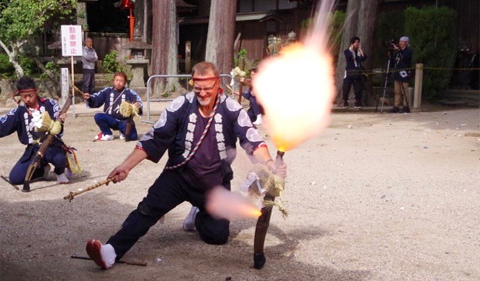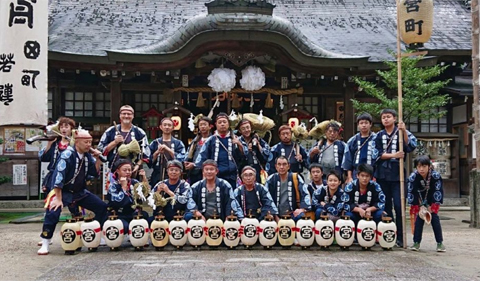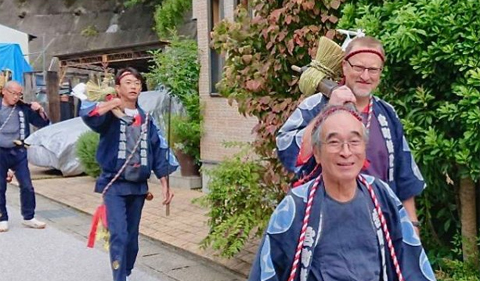
Dr. Chris Thompson firing his assigned flintlock musket at Asuke Hachimangū Shrine on the first day of the Asuke Fall Matsuri.
On a weekend in early October, Dr. Christopher S. Thompson, Associate Professor of Linguistics, became the first foreigner to fire a flintlock musket as a full participant and member of the Miyamachi Teppōtai (musket troupe).
Thompson was participating in a traditional shrine festival (matsuri) held annually in Asuke, a mountain hamlet located in Toyota City, 40 miles from Chubu University. Thompson, the current Miura Visiting Professor at Chubu University, is a cultural anthropologist who studies the intersection of tradition and modernity in contemporary Japan.
“This experience is the epitome of participant observation…,” he suggests, “… a research technique commonly used by ethnologists in the field like me to glean the local perspective.”
The purpose of Thompson’s research is to understand the important role the musket troupe continues to play in helping its members to preserve their neighborhood (Miyamachi) and the Asuke economy—both experiencing population decline—by continuing the practice of Hōnō Deppō, the use of Japanese hinawajū [flintlock muskets] as a divination tool in the local fall festival.

Thompson and his troupe mates on Oct. 13 on the afternoon before the start of the Asuke Fall Matsuri after being blessed by the head priest of Asuke Hachimangū Shrine.
Thompson has the full support of the Asuke community. Quite strategically, a day before the Fall Matsuri, an article appeared in local newspapers profiling his connection to Asuke and the Teppotai to help promote his project.
Unlike Ikusa Deppō (“skirmish” muskets) used in historic battle reenactments throughout Japan, in Asuke, Hōnō Deppō (which are relatively rare) are tied to the local Asuke Hachimangū Shrine (Shinto). They are fired only during the Fall Matsuri to announce the local deity’s presence and to bless and purify those in the vicinity of the intentionally deafening and artistically colorful blasts that come from each musket charge. Thompson described the volume of the musket discharges as, “the loudest sounds I have ever heard!”
For this matsuri, the Miyamachi community deploys 10 to 12 troupe members at designated times during two full festival days (about three times an hour from 9 a.m. to 5 p.m.), marching to pre-designated locations within the hamlet bounds to discharge their muskets in succession. Local residents and visitors observe the troupe at their preferred viewing location at a safe distance determined by municipal authorities and the local police – with the purpose of being renewed, revived, and purified in preparation for the winter months ahead.
Over the next few weeks, Thompson is scheduled to give several research lectures on his Asuke experience to Chubu faculty and students. Thompson hopes some of the 10 OHIO students currently studying at Chubu will be able to attend. Thompson aims to have a journal article about the Miyamachi Teppōtai by early summer.




















Comments